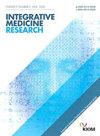针刺治疗保留比目鱼肌质量,改善废用性萎缩大鼠线粒体功能
IF 3
4区 医学
Q2 INTEGRATIVE & COMPLEMENTARY MEDICINE
引用次数: 0
摘要
背景:肌肉萎缩导致身体机能的衰弱性丧失,特别是当需要替代治疗时。针刺被认为是废用性萎缩的潜在治疗方法,但其对肌肉生物学的影响尚不清楚。本研究评估了针刺对大鼠固定运动萎缩模型比目鱼肌质量和线粒体功能的影响。方法将雌性Sprague Dawley大鼠随机分为3组:对照组(CON)、穿刺固定组(CT)和针刺固定组(CT- a)。左后肢固定14天,针刺特定穴位(胃-36、胆囊-34),每周3次,每次15分钟。观察皂素渗透纤维的线粒体功能,并通过Western blot分析调节肌肉质量的信号分子。结果与CT相比,sct - a能减轻比目鱼肌萎缩。在脂肪酸底物条件下,与CON相比,CT减少了复合物I和ii支持的氧化磷酸化(OXPHOS),而CT- a相对于CT减少了呼吸泄漏并增强了OXPHOS偶联。在不含脂肪酸的情况下,与CON相比,CT- a减少了呼吸泄漏和复合物I和ii支持的OXPHOS,但CT和CT- a之间的差异不显著。与CON组相比,CT组AMPKα活性(p-AMPKα/AMPKα)显著升高,但在CT- a组恢复到CON水平。然而,与肌肉萎缩或自噬标志物相关的蛋白质在各组之间没有变化。结论针刺可减轻固定运动引起的肌肉萎缩,并保留线粒体功能,提示针刺可作为肌肉废用症的治疗方法。本文章由计算机程序翻译,如有差异,请以英文原文为准。
Acupuncture treatment preserves soleus muscle mass and improves mitochondrial function in a rat model of disuse atrophy
Background
Muscle atrophy leads to debilitating loss of physical capacity, particularly when alternative treatments are needed. Acupuncture is proposed as a potential therapy for disuse atrophy, but its effects on muscle biology remain unclear. This study evaluated the effects of acupuncture on soleus muscle mass and mitochondrial function in a rat model of immobilization-induced atrophy.
Methods
Female Sprague Dawley rats were assigned to three groups: Control (CON), casting-induced immobilization (CT), and CT with acupuncture (CT-A) (n = 8). Immobilization of the left hindlimb lasted for 14 days, and acupuncture was performed at specific acupoints (stomach-36, gallbladder-34) three times per week for 15 min. Mitochondrial function was assessed in saponin-permeabilized fibers, and signaling molecules regulating muscle mass were analyzed by Western blot.
Results
CT-A attenuated soleus muscle atrophy compared to CT. Under fatty acid substrate conditions, CT reduced complex I and II-supported oxidative phosphorylation (OXPHOS) compared to CON, while CT-A decreased respiratory leak and enhanced OXPHOS coupling relative to CT. Without fatty acids, CT-A decreased both respiratory leak and complex I and II-supported OXPHOS compared to CON, but differences between CT and CT-A were not significant. AMPKα activity (p-AMPKα/AMPKα) was significantly elevated in the CT group compared to the CON group, but returned to CON levels in the CT-A group. However, there were no changes in proteins associated with muscle atrophy or autophagy markers among the groups.
Conclusion
Acupuncture mitigates immobilization-induced muscle atrophy and preserves mitochondrial function, suggesting its potential as a therapeutic approach for muscle disuse conditions.
求助全文
通过发布文献求助,成功后即可免费获取论文全文。
去求助
来源期刊

Integrative Medicine Research
Medicine-Complementary and Alternative Medicine
CiteScore
6.50
自引率
2.90%
发文量
65
审稿时长
12 weeks
期刊介绍:
Integrative Medicine Research (IMR) is a quarterly, peer-reviewed journal focused on scientific research for integrative medicine including traditional medicine (emphasis on acupuncture and herbal medicine), complementary and alternative medicine, and systems medicine. The journal includes papers on basic research, clinical research, methodology, theory, computational analysis and modelling, topical reviews, medical history, education and policy based on physiology, pathology, diagnosis and the systems approach in the field of integrative medicine.
 求助内容:
求助内容: 应助结果提醒方式:
应助结果提醒方式:


